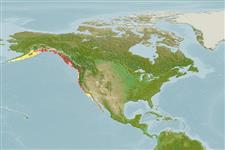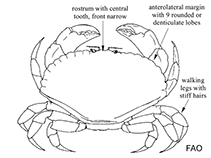Advertisement
Cancer productus Randall, 1840
Red rock crab| Native range | All suitable habitat | Point map | Year 2050 |

|
| This map was computer-generated and has not yet been reviewed. |
| Cancer productus AquaMaps Data sources: GBIF OBIS |
Upload your photos
Google image | No image available for this species;
drawing shows typical species in Cancridae.
Google image | No image available for this species;
drawing shows typical species in Cancridae.
United States (contiguous states) country information
Common names:
[No common name]
Occurrence: native
Salinity: marine
Abundance: | Ref:
Importance: | Ref:
Aquaculture: never/rarely | Ref:
Regulations: no regulations | Ref:
Uses: no uses
Comments: C: Refs. 78177, 78494, 93916, 865, 78677; R: Ref. 78177.
National Checklist:
Country Information: https://www.cia.gov/library/publications/resources/the-world-factbook/geos/us.html
National Fisheries Authority: http://www.nmfs.gov
Occurrences: Occurrences Point map
Main Ref: Jensen, G.C., 1995
National Database:
Occurrence: native
Salinity: marine
Abundance: | Ref:
Importance: | Ref:
Aquaculture: never/rarely | Ref:
Regulations: no regulations | Ref:
Uses: no uses
Comments: C: Refs. 78177, 78494, 93916, 865, 78677; R: Ref. 78177.
National Checklist:
Country Information: https://www.cia.gov/library/publications/resources/the-world-factbook/geos/us.html
National Fisheries Authority: http://www.nmfs.gov
Occurrences: Occurrences Point map
Main Ref: Jensen, G.C., 1995
National Database:
Common names from other countries
Classification / Names Common names | Synonyms | Catalog of Fishes (gen., sp.) | ITIS | CoL | WoRMS
Environment: milieu / climate zone / depth range / distribution range Ecology
Benthic; depth range 0 - 90 m (Ref. 78177). Subtropical, preferred 9°C (Ref. 107945); 61°N - 30°N, 168°W - 116°W (Ref. 78486)
Distribution Countries | FAO areas | Ecosystems | Occurrences | Introductions
Eastern Pacific: Nunivak and Kodiak Islands, Alaska to Isla San Martin, Baja California. Subtropical to temperate.
Length at first maturity / Size / Weight / Age
Maturity: Lm ? range ? - ? cm Max length : 20.0 cm CW male/unsexed; (Ref. 78486)
Depth range is from intertidal to about 90 m. Max size from male specimen captured off Punta Banda, Baja California (Ref. 78177). Forages on shores protected from wave action. Juveniles and mating pairs occur in the intertidal zone only on nocturnal high tides (Ref. 78483). Buries itself in the substrate during periods of inactivity (Ref. 78491). Excavating predator (Ref. 78493).
Life cycle and mating behavior Maturity | Reproduction | Spawning | Eggs | Fecundity | Larvae
Most species produce a single brood each winter but may reach up to two or three broods per year and the reproductive life span is about 4 years. The cumulative number of broods produced over the maximum life span is about 4 broods.
Main reference
References | Coordinator | Collaborators
Jensen, G.C. 1995. (Ref. 78177)
IUCN Red List Status
(Ref. 130435: Version 2024-2)
CITES status (Ref. 108899)
Not Evaluated
CMS (Ref. 116361)
Not Evaluated
Human uses
Fisheries: commercial
FAO - Fisheries: landings | FishSource | Sea Around Us
Tools
More information
Internet sources
BHL | BOLD Systems | CISTI | DiscoverLife | FAO(Fisheries: ; publication : search) | GenBank (genome, nucleotide) | GloBI | Gomexsi | Google Books | Google Scholar | Google | PubMed | Tree of Life | Wikipedia (Go, Search) | Zoological Record
Estimates based on models
Preferred temperature
(Ref. 115969): 8 - 12.1, mean 9.6 (based on 82 cells).




